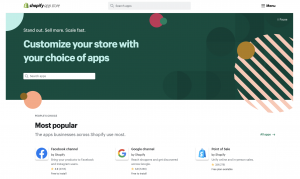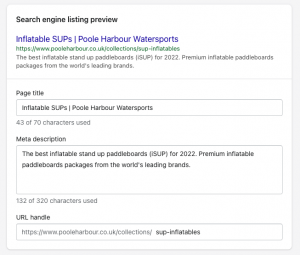June 23, 2022
WooCommerce vs Shopify: What’s The Best eCommerce Platform?
Table of Contents
[lwptoc skipHeadingLevel=”h3,h4,h5,h6″]
So you have just started your eCommerce business! You have chosen your business name, created an eye-catching logo and branding and developed your amazing products. Now it’s time to choose the right eCommerce platform for your online store. When starting an eCommerce business, picking the right platform is one of the most critical decisions, with many different variables to consider.
An eCommerce platform is a software in which businesses launch, host, and manage their online stores, and it’s essentially the backbone of any online retailer. The platform provides features that allow merchants to build a branded online storefront to sell their products and services.
Shopify and WooCommerce are two of the top eCommerce platforms in the world, each with its pros and cons. This guide will present you with a detailed comparison of the two eCommerce platforms. The goal is to break down their advantages and disadvantages to help you choose the best option for your eCommerce store.
Key Aspects Of WooCommerce And Shopify
Both eCommerce platforms will allow you to create an online store, add and modify your content, process orders, and collect payments, among others. But before you get started with either of them, it would be wise to get familiar with the key aspects of both.
WooCommerce is an open-source e-commerce plugin designed for small to large-sized online merchants using WordPress, an open-source platform. Launched on September 27, 2011, the plugin quickly became popular for its simplicity to install and customise and for the market position of the base product as freeware. Since WordPress is a self-hosted platform, you must buy hosting, worry about an SSL certificate, and purchase a domain name. But if you’re all for being able to tweak everything, then WooCommerce is perfect for you, but you need some coding knowledge.
On the other hand, Shopify offers a subdomain and hosting space for your eCommerce store, security, and you don’t need to use any coding to build your online store. Shopify also offers online retailers a suite of services, including payments, marketing, shipping and customer engagement tools. On the downside, it is the only platform to enforce its own transaction fee unless you use its gateway, Shopify Payments
Pricing
As you can imagine, WooCommerce and Shopify differ significantly in pricing:
WooCommerce pricing
WooCommerce and WordPress are both free, open-source software. Free is great, right? Nevertheless, when it comes to WooCommerce pricing, there are still some costs involved in launching a new online store using WooCommerce. But, like the software itself, costs are customisable. That means you have much more control over what you spend and when compared with most other eCommerce platforms.
As we mentioned before, WordPress is a self-hosted platform, so the very first thing you’ll need to do is choose a hosting service for your store and buy a plan. The following cost is registering a domain. Expect to pay about £12 per year for each domain name you use. After you have paid for hosting and a domain there are some optional costs you might consider.
The first one would be your eCommerce website theme. There are several free WordPress themes that are optimised for eCommerce. Among them is WooCommerce’s official Storefront theme, built and maintained by WooCommerce core developers, so you can rest assured there weren’t any issues during major WooCommerce updates.

After choosing the ideal theme for your eCommerce website, you might need to consider shipping and payment gateways. Out of the box, WooCommerce provides options for flat rate shipping, free shipping, and local pickup while the free WooCommerce Shipping extension is an excellent option for US-based online retailers that connects to USPS DHL and allows you to print shipping labels right from your WordPress dashboard. If you need more advanced shipping options, plenty of paid shipping, delivery, and fulfilment extensions are available.
In terms of payments, one of the simplest options is to use WooCommerce Payments, which allows you to manage payments directly in your WooCommerce Dashboard. It has no setup charge and no monthly fees, but you pay 2.9% + 20p for each transaction made with US-issued credit or debit cards. There’s an additional 1% fee for cards issued outside the US. WooCommerce Payments is currently available to merchants based in Australia, Austria, Belgium, Canada, France, Germany, Hong Kong, Ireland, Italy, Netherlands, New Zealand, Poland, Portugal, Singapore, Spain, Switzerland, United Kingdom, and the United States and you can accept payments in more than 135 currencies.
Shopify pricing
Whereas WooCommerce is more flexible, Shopify has set pricing. Their Basic plan starts at £24 per month, and you can upgrade to the Shopify plan for £69 or the Advanced Shopify plan for £259 per month, depending on what extra features you would like for your eCommerce store. Shopify offers a 14-day free trial, a 10% discount on annual plans, and 20% on biennial plans when paid upfront. Each plan includes a free SSL certificate and web hosting and comes with a Shopify branded subdomain (e.g. https://your-store.myshopify.com). If you want to use your domain name, you’ll need to purchase it separately. Pricing for a regular .com domain name generally starts at £9 per year.

In terms of payments, Shopify is the only platform to enforce its own flat transaction fee of 2.0%, 1.0%, and 0.5% (respectively for the Basic plan to Advanced plan) for all transactions, unless you use its payment gateway, Shopify Payments. With Shopify Payments, the credit card rates / payment processing rates are 2.9% + 20p cents per transaction for the basic plan, 2.6% + 20p cents per transaction for the Shopify plan, and 2.4% + 20p cents per transaction for the Advanced Shopify plan. Also, remember that in addition to the Shopify fee, some apps and add-ons have fees per transaction.
Integrations and Add-ons
Both platforms allow you to install apps and plugins to add extra functionality in various areas of your business.
WooCommerce extensions store

WooCommerce, as open-source software, relies heavily on plugins for most of its features. Hundreds of free plugins are available, and many more paid ones to choose from. You can use these extensions to add payment gateways, shipping options, analytics, lead generation, eCommerce SEO, performance optimisation, social media integration, and more. The majority of third-party tools and service providers have their own plugins that can integrate with your WooCommerce store.
Another benefit of using open-source software is that you can modify any part of the code to achieve exactly the functionality and data flow you need. That means that if you have the money and time, you can hire a WordPress developer to create a bespoke integration, theme, or plugin just for your eCommerce website. For example, you can create bespoke plugins to pull data from your various stock control systems or make bulk imports from spreadsheets.
Shopify app store

The Shopify App Store offers a collection of free and paid plugins that extend the functionality of your online store. Additionally, with the Shopify API, you can use the programming language of your choice to create new apps, and you can even share them with other merchants on the Shopify App Store, but you need to register for a Shopify Partner account first.
Scalability and Growth
To support your business’s growth, your site must be equipped to handle high traffic volume and transaction spikes. Shopify and WooCommerce can be scaled to handle an increase in traffic and orders, but there are some crucial differences.
Scalability on WooCommerce
A myth about WooCommerce is that it doesn’t have scaling capabilities. Supposedly, it works fine for small stores but not so well for fast-growing or enterprise-size eCommerce businesses. But the truth is that the flexibility of WooCommerce makes it an excellent solution for large stores. The amount of traffic your store can handle largely depends on your hosting environment. WooCommerce is a self-hosted platform which means that as your business grows, your starter WooCommerce hosting plan would run out of resources as your store starts getting more traffic and transactions.
So, If your server cannot handle your growing website, you can simply upgrade your hosting plan or choose a different hosting company that can support your business’s scaling. With WooCommerce, you are in full control of your eCommerce website, so you have numerous growth management options to choose from. As your business grows, your WooCommerce hosting costs will increase, but you will have better control over what you upgrade, and you can ensure you are not paying for resources you don’t need.
Nevertheless, despite the amount of control and customisation that WooCommerce offers, many small business owners would instead use their time to grow their business rather than looking at upgrading their hosting package. So they would simply look for a hassle-free solution to their scaling problem.
Scalability on Shopify

Shopify might not be as customisable as WooCommerce, but it handles all technical parts of your store, so you don’t ever have to worry about performance or scalability. Does your business start rapidly growing? Simply upgrade your Shopify plan. It’s point-and-click scaling, so you don’t have to build the architecture and don’t have to worry about dealing with hosting solutions. And if your business is getting really big, the company also offers enterprise services as part of their Shopify Plus plan.
SEO
Search Engine Optimization (SEO) is key to attracting customers to your eCommerce site. Luckily, both platforms have a lot to offer. But which one is better equipped to help your eCommerce site climb the search engine rankings and ensure your products appear in front of the right people?
WooCommerce SEO
WooCommerce is built using code optimised for SEO so you can easily customise your URLs, add detailed meta descriptions and meta titles to your online store’s pages, add structured data, and include alt text to your product images, among others. WooCommerce also offers numerous SEO plugins (many of them are free or offer free versions) that allow you to optimise your store, with Yoast SEO being considered the most well-known SEO plugin. By using SEO plugins on your WooCommerce site, you can make sure your site meets the highest technical SEO standards.
Shopify SEO
Shopify offers basic SEO features and has plenty of built-in features and apps that could effectively get your online store’s pages indexed and ranked in search engines. Shopify also offers a range of SEO plugins in its App Store, making it easy to add basic SEO information to your store. You can easily add meta descriptions and titles to your pages and see how they would appear as a Google result.

Nevertheless, Shopify shows some limitations in terms of SEO. Since Shopify is a closed platform, it allows less flexibility and customisations than other open platforms like WooCommerce. One of the most critical limitations is that you cannot fully customise your Shopify store’s URLs. That’s because Shopify has a very rigid URL structure, and some sections of your store URLs simply cannot be modified.
WooCommerce vs Shopify: Which is better?
Comparisons like this are never simple and which platform is better depends mainly on your business requirements. That being said, we believe that WooCommerce provides excellent value for money. It’s free to install and offers many free or very reasonably priced extensions that help you add greater functionality to your online store at a low cost. Also, as an open-source platform, it offers limitless customisation and scalability. On the other hand, WooCommerce is not entirely beginner-friendly. Although it provides a lot of free templates, without some basic coding knowledge, you’ll struggle to build an online store exactly as you want it.
Suppose you’re new to eCommerce, or you simply don’t want to bother about any of the technical details of your eCommerce store. In that case, Shopify includes hosting and security, and, most importantly, you don’t need to write a single line of code to build a fantastic online store. Shopify offers 24/7 support and allows you to sell as a build-in feature on other channels like Amazon, Facebook, etc. The main downside is that Shopify enforces its transaction fee unless you use its gateway, Shopify Payments.
How can Fanatic help with your eCommerce website?

If you’re looking for an eCommerce partner that delivers results and stands for excellence, accountability, and expertise, look no further. With over 20 years of experience, we design and build bespoke eCommerce websites that convert, work seamlessly across mobile, tablet and desktop devices, are search engine friendly, easy for your customers to use and easy for you to update.
We work with several eCommerce software platforms and consider your business requirements to decide which would be best suited to your site. Our developers work alongside our Design and Digital Marketing teams to create a fully fleshed-out eCommerce strategy that recognises customer behaviour patterns and offers a unique user experience.
Our methods are results-driven, and we consistently monitor and adjust them as needed to create engaging, secure and high-converting eCommerce sites and apps. Our developers are always on hand to make suggestions and implement solutions to ensure your site remains a go-to resource for your customers.
